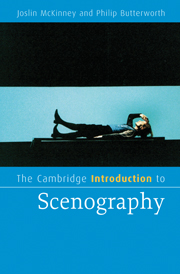Book contents
- Frontmatter
- Contents
- List of illustrations
- List of boxed quotations
- Preface
- Acknowledgements
- Part 1 Elements
- Part 2 Processes of scenography
- Part 3 Realisation and reception
- Chapter 6 Analysis of scenography
- Chapter 7 Reception of scenography
- Chapter 8 Completion and exchange of the image
- Notes
- Bibliography
- Index
- Cambridge Introductions to …
Chapter 7 - Reception of scenography
Published online by Cambridge University Press: 05 February 2015
- Frontmatter
- Contents
- List of illustrations
- List of boxed quotations
- Preface
- Acknowledgements
- Part 1 Elements
- Part 2 Processes of scenography
- Part 3 Realisation and reception
- Chapter 6 Analysis of scenography
- Chapter 7 Reception of scenography
- Chapter 8 Completion and exchange of the image
- Notes
- Bibliography
- Index
- Cambridge Introductions to …
Summary
The previous chapter moved from consideration of the analysis of scenography as an object to a concern with the scenographic event. This chapter concentrates on the experience and reception of scenography. This, of necessity, involves consideration of the audience as an active agent.
Analyses of performances, or the ways in which the mise-en-scène works, are governed by the person(s) conducting the analysis, who ‘have neither the apparent objectivity of empirical observation, nor the absolute universality of abstract theory; they negotiate a space between detailed yet fragmentary description and general unverifiable theory, between formless signifiers and polysemic signifieds’. The richness of the theatrical experience and its reception means that performance varies from one spectator to another. The idea of the spectator as ‘reader’ has some interesting implications in terms of the way theatre, and scenography in particular, as a form of communication is conceptualised.
As noted in relation to semiotics, theatre theorists have found useful models in the fields of linguistics and literature which can be applied to ‘reading’ the theatre event. Susan Bennett gives a very clear account of how reception theory and reader-response criticism might be used to think about the ‘emancipation’ of audiences and the diversity of roles that they can take on in the variety of forms which make up contemporary theatre and performance practice. Furthermore, ideas that arise from semiotics and post-structuralist thinking also inform ideas about the active role of audiences at ‘the nexus of production and reception’.
- Type
- Chapter
- Information
- The Cambridge Introduction to Scenography , pp. 171 - 188Publisher: Cambridge University PressPrint publication year: 2009



